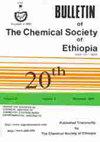潜在抗菌剂(Z)-4-((4-硝基苯基)氨基)戊-3-烯-2-酮锌(II)配合物的合成、表征、抗菌筛选、DFT计算和对接研究
IF 2.3
4区 化学
Q3 CHEMISTRY, MULTIDISCIPLINARY
引用次数: 3
摘要
摘要。本文报道了(Z)-4-((4-硝基苯基)氨基)戊-3-烯-2-酮(HL)配体及其Zn(II)配合物的合成和表征。使用元素和热重分析(TGA)、电化学研究、FTIR、UV-Vis、1H和13C对化合物进行了表征{H}NMR、HRMS和PXRD技术。对部分革兰氏阳性菌和革兰氏阴性菌进行了抗菌活性筛选。DFT预测是使用B3LYP、ωB97XD和M06-2X函数实现的,非金属原子和金属原子分别具有6-31+G(d,p)和LANL2DZ基集。基于蛋白质结合亲和力、ADME/T和药物相似性来评估化合物的治疗潜力。实验结果揭示了两个配体通过其羰基和氨基以四面体排列与锌离子配位的络合物的形成。抗菌研究表明,该配合物具有比游离配体和对照(链霉素)更高的抗菌活性。B3LYP是表现最好的官能团,其产生了相对于实验数据最好的IR光谱和几何参数。密度泛函理论(DFT)预测表明,该配合物比配体更具活性,其形成在热力学上是可行的,并且是放热的。对接结果表明,这些化合物的结合亲和力与体外数据一致,并且具有类药物性质。关键词:席夫碱,锌络合物,抗菌剂,DFT,对接研究公牛。化学。Soc.Ethiop。2023,37(3),633-651.DOI:https://dx.doi.org/10.4314/bcse.v37i3.8本文章由计算机程序翻译,如有差异,请以英文原文为准。
Zinc(II) complex of (Z)-4-((4-nitrophenyl)amino)pent-3-en-2-one, a potential antimicrobial agent: synthesis, characterization, antimicrobial screening, DFT calculation and docking study
ABSTRACT. Herein, the synthesis and characterizations of (Z)-4-((4-nitrophenyl)amino)pent-3-en-2-one (HL) ligand and its Zn(II) complex are reported. The compounds were characterized using elemental and thermogravimetric (TGA) analysis, electrochemical studies, FTIR, UV-Vis, 1H and 13C{H}NMR, HRMS, and PXRD techniques. Antimicrobial activity was screened on some Gram-positive and Gram-negative bacteria. DFT predictions were achieved using B3LYP, ωB97XD and M06-2X functional with 6-31+G(d,p) and LANL2DZ basis sets for nonmetallic and metallic atoms, respectively. The therapeutic potentials of the compounds were evaluated based on protein binding affinity, ADME/T and drug-likeness properties. The experimental results revealed the formation of a complex in which two ligands coordinated to the zinc ion in a tetrahedral arrangement through their carbonyl and amino groups. The antimicrobial study showed that the complex possesses higher antimicrobial activity than free ligand and the control (Streptomycin). B3LYP emerged as the best performing functional having yielded the best IR spectra and geometrical parameters relative to the experimental data. The density functional theory (DFT) predictions revealed that the complex is more active than the ligand, and its formation is thermodynamically feasible and exothermic. The docking results revealed that the binding affinities of the compounds are in agreement with the in-vitro data, and they possess drug-like properties.
KEY WORDS: Schiff base, Zinc complex, Antimicrobial, DFT, Docking study
Bull. Chem. Soc. Ethiop. 2023, 37(3), 633-651.
DOI: https://dx.doi.org/10.4314/bcse.v37i3.8
求助全文
通过发布文献求助,成功后即可免费获取论文全文。
去求助
来源期刊
CiteScore
2.20
自引率
8.30%
发文量
113
审稿时长
6-12 weeks
期刊介绍:
The Bulletin of the Chemical Society of Ethiopia (BCSE) is a triannual publication of the Chemical Society of Ethiopia. The BCSE is an open access and peer reviewed journal. The BCSE invites contributions in any field of basic and applied chemistry.

 求助内容:
求助内容: 应助结果提醒方式:
应助结果提醒方式:


